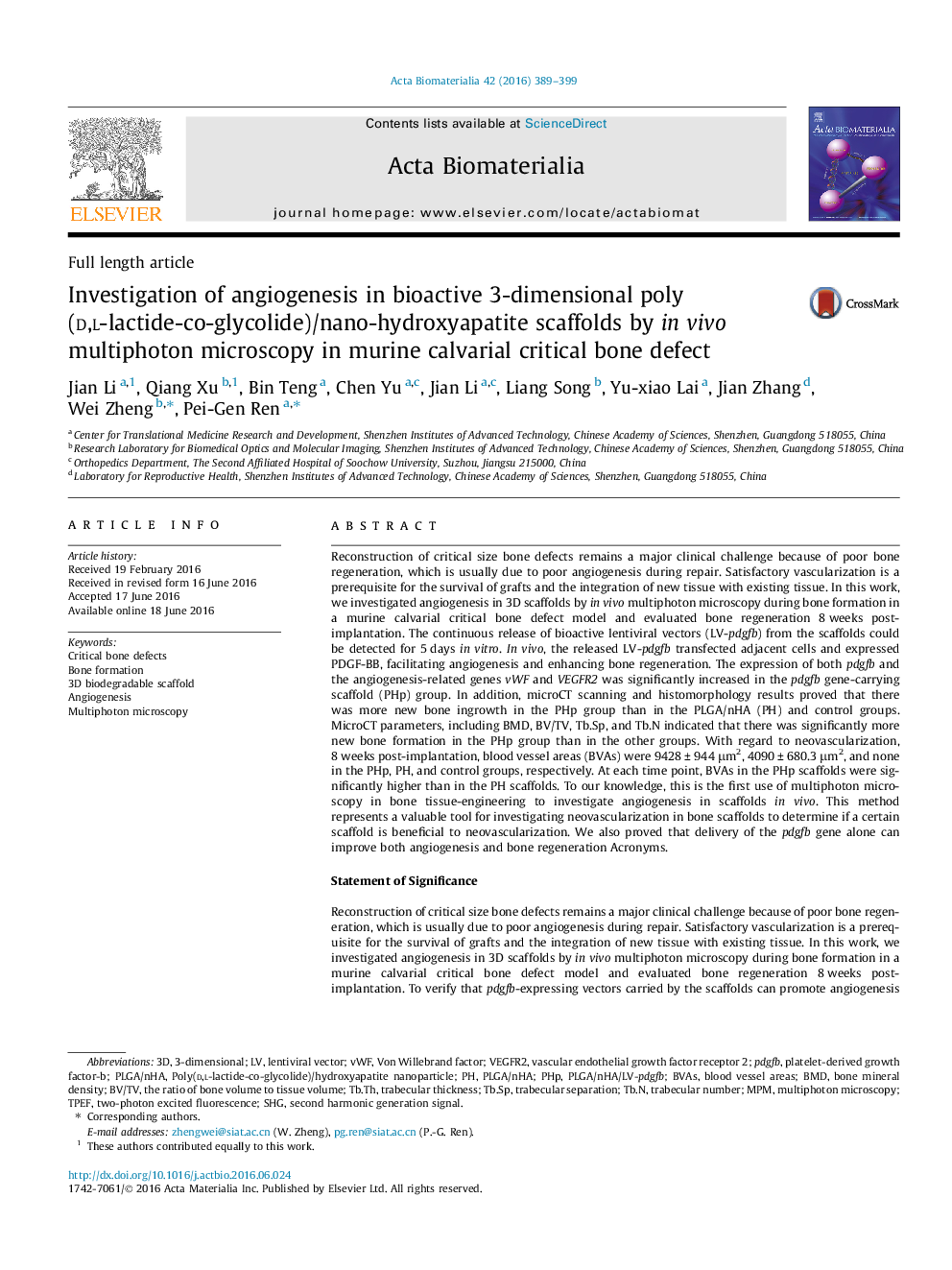| کد مقاله | کد نشریه | سال انتشار | مقاله انگلیسی | نسخه تمام متن |
|---|---|---|---|---|
| 6450261 | 1415944 | 2016 | 11 صفحه PDF | دانلود رایگان |

Reconstruction of critical size bone defects remains a major clinical challenge because of poor bone regeneration, which is usually due to poor angiogenesis during repair. Satisfactory vascularization is a prerequisite for the survival of grafts and the integration of new tissue with existing tissue. In this work, we investigated angiogenesis in 3D scaffolds by in vivo multiphoton microscopy during bone formation in a murine calvarial critical bone defect model and evaluated bone regeneration 8 weeks post-implantation. The continuous release of bioactive lentiviral vectors (LV-pdgfb) from the scaffolds could be detected for 5 days in vitro. In vivo, the released LV-pdgfb transfected adjacent cells and expressed PDGF-BB, facilitating angiogenesis and enhancing bone regeneration. The expression of both pdgfb and the angiogenesis-related genes vWF and VEGFR2 was significantly increased in the pdgfb gene-carrying scaffold (PHp) group. In addition, microCT scanning and histomorphology results proved that there was more new bone ingrowth in the PHp group than in the PLGA/nHA (PH) and control groups. MicroCT parameters, including BMD, BV/TV, Tb.Sp, and Tb.N indicated that there was significantly more new bone formation in the PHp group than in the other groups. With regard to neovascularization, 8 weeks post-implantation, blood vessel areas (BVAs) were 9428 ± 944 μm2, 4090 ± 680.3 μm2, and none in the PHp, PH, and control groups, respectively. At each time point, BVAs in the PHp scaffolds were significantly higher than in the PH scaffolds. To our knowledge, this is the first use of multiphoton microscopy in bone tissue-engineering to investigate angiogenesis in scaffolds in vivo. This method represents a valuable tool for investigating neovascularization in bone scaffolds to determine if a certain scaffold is beneficial to neovascularization. We also proved that delivery of the pdgfb gene alone can improve both angiogenesis and bone regeneration Acronyms.Statement of SignificanceReconstruction of critical size bone defects remains a major clinical challenge because of poor bone regeneration, which is usually due to poor angiogenesis during repair. Satisfactory vascularization is a prerequisite for the survival of grafts and the integration of new tissue with existing tissue. In this work, we investigated angiogenesis in 3D scaffolds by in vivo multiphoton microscopy during bone formation in a murine calvarial critical bone defect model and evaluated bone regeneration 8 weeks post-implantation. To verify that pdgfb-expressing vectors carried by the scaffolds can promote angiogenesis in 3D-printed scaffolds in vivo, we monitored angiogenesis within the implants by multiphoton microscopy. To our knowledge, this is the first study to dynamically investigate angiogenesis in bone tissue engineering scaffolds in vivo.
132
Journal: Acta Biomaterialia - Volume 42, 15 September 2016, Pages 389-399